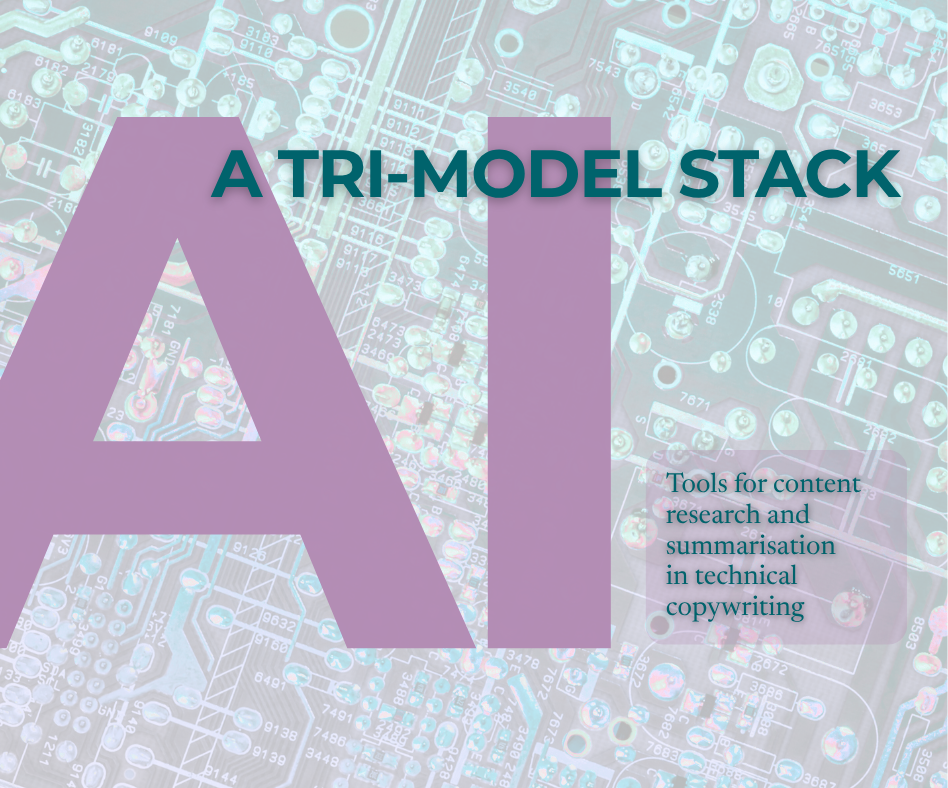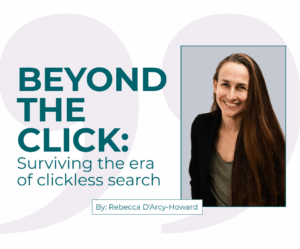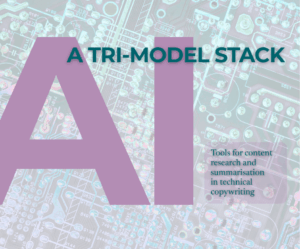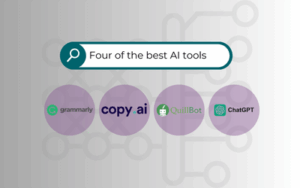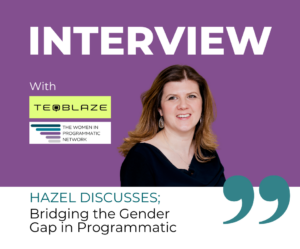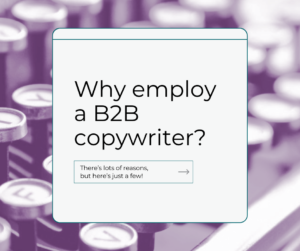AI tools for content research and summarisation in technical copywriting
If you’re looking to blend human skill with AI speed in your content workflow, especially for research-heavy or technical copy, this report is for you.
A few months back, we shared our top picks for AI tools in copywriting. Now we’ve taken things further, comparing eight popular models (four free-to-use tools alongside their play-to-play versions) to see which ones actually deliver when it comes to summarising in-depth material, pulling live data, and staying reliable under pressure.
Summary
Eight frontier LLM variants were compared: ChatGPT GPT-4o, ChatGPT o3, Anthropic Claude Opus 4, Anthropic Claude Sonnet 4, Perplexity Sonar‑Large, Perplexity R1 1776, Google Gemini 2.5 Pro, and Google Gemini 2.5 Flash.
Three criteria were used: (i) long‑context summarisation of dense technical material, (ii) live‑web research with verifiable citations, and (iii) user‑reported reliability from Reddit, StackExchange, and specialist adtech communities.
Perplexity Sonar, backed by its real‑time crawler, yields the fastest, citation‑rich scans of evolving information, whilst Claude Opus 4 produces the most faithful long‑context summaries. GPT‑4o remains the most versatile copy‑rewriter.
For technical copywriters, the optimum stack is therefore tri‑modal: use Perplexity Pro to harvest and cite sources, pass full documents into Claude Opus 4 for structured distillation, then (optionally) refine tone, voice, and compliance wording in GPT‑4o. This workflow minimises hallucinations and preserves nuance. The combined subscription spend of this workflow is approximately £50 per month (charged in USD).
To add images, open a parallel GPT-4o chat titled “Visual concepts for <>”, drop in Claude’s distilled bullet points, then ask it to create the desired number of brand-safe visuals, embedding the specified keywords on-image. If deeper inpainting or multi-turn tweaks are needed, upload the selected GPT-4o output to Gemini 2.5 Pro and refine conversationally.
About tokens and context windows
“Tokens” are the units into which an LLM model breaks down text before neural processing. They can be a whole word, a sub-word fragment, punctuation, or sometimes a space. In English, a good rule of thumb is that 1 token ≈ 4 characters, or ≈ 0.75 words (range 0.5 – 2 words depending on language, spelling, and punctuation).
The “context window” is the number of tokens an AI model can handle. Therefore, to ensure a model can handle a text input, multiply the word count by 1.3.
About weights
“Weights” are the billions of adjustable numbers a language model tunes during training, and determine how strongly one artificial neuron influences another. Once the model is finished, the weights are frozen. When the weights are “open”, a file containing them is published under a licence that lets anyone download, inspect, and modify them locally.
Comparison Table
| Model | Context Window | Strengths | Cost Per Month | Image Generation | |
| ChatGPT GPT‑4o | 128,000 tokens [5] | Fast multimodal rewriting, code‑assisted formatting | Citation links can be brittle, smaller window than Claude / Gemini for giant PDFs | ChatGPT Plus: 20 USD ≈ 16 GBP [1] | Yes – photorealistic, text-accurate, basic in-chat edits [14, 15] |
ChatGPT o3 | 128,000 tokens [5] | Deep step‑by‑step reasoning for data‑heavy copy | Slower, sometimes terse summaries | Included in ChatGPT Plus | Yes – shares DALL-E 3 backend, fewer creative controls [14, 15] |
Claude Opus 4 | 200,000 tokens [6] | Highest fidelity long‑doc summarisation, low hallucination | No native web browsing, higher API cost | Claude Pro: 16 GBP [2] | No – analysis only, no visual output [17] |
| Claude Sonnet 4 | 100,000 tokens [6] | Fast, cheaper, “thinking‑out‑loud” style | Smaller window than Opus, free tier heavily throttled | Free tier; full power in Claude Pro | No – analysis only [17] |
| Perplexity Sonar‑Large | 32,000 tokens [7] | Instant live‑web answers with inline citations | Shorter window, concise not deep | Perplexity Pro: 20 USD ≈ 16 GBP [3] | Yes – DALL-E 3 backend, no iterative edits [18] |
Perplexity R1 1776 | 163,000 thousand tokens [9] | Open weights, uncensored reasoning, bigger window | Slower, text‑only, limited creative tone | Included in Perplexity Pro | Yes – same Sonar engine, no edits [18] |
| Gemini 2.5 Pro | Up to one million tokens [8] | Deep Research agent auto‑builds long reports inside Google Docs | “Lost‑in‑the‑middle” and lazy summarisation complaints, slower | Google One AI Premium: 19.99 USD ≈ 16 GBP[4] | Yes – Imagen 4, fast multi-turn edits, realism mixed [16] |
| Gemini 2.5 Flash | One million tokens (benchmarked) [8] | Lightning speed for quick fact checks | Less nuance, weaker on huge policy PDFs | Free Google account | Yes – Imagen 4, limited edit features [16] |
1. Research performance
Perplexity’s Sonar routinely beats rivals on freshness and citation hygiene; power users replaced Google Search for tasks like “latest Chrome Privacy Sandbox rollout dates” or “CTV supply‑path changes” [13]. GPT‑4o can pull Bing snippets but still hallucinates URLs, so writers must double‑check [12]. Gemini Deep Research delivers multi‑page overviews in minutes, yet Reddit testers report sporadic failures and verbose padding – unacceptable when deadlines sit inside agency sprint cycles [11]. Claude lacks live browsing, forcing manual upload of spec sheets. However, once provided, its analytical depth is unmatched [10].
2. Economics and fees
All four vendors cluster around a £16‑20 monthly ceiling for prosumer access. Perplexity’s single fee unlocks Sonar plus third‑party models, effectively arbitraging competitors’ strengths [3]. Claude Pro is the clear value pick when daily workloads include analysis of long documents, whilst ChatGPT Plus is the cheapest path to multimodal creativity. Google’s bundle offsets its cost via two terabytes of Drive storage [4].
3. Image generation and editing overview
ChatGPT’s DALL-E 3 pipeline tops community tests for photorealism, prompt adherence, and accurate typography, although its mask-based editor often re-renders the whole frame and daily quotas stay tight [14, 15]. Gemini 2.5 Pro couples Imagen 4 with lightning-fast conversational inpainting (reconstructing damaged parts of an image, or filling in missing portions). Its speed impresses power users, yet realism is inconsistent and strict safety filters block certain subjects [16]. Perplexity Pro exposes both the OpenAI backend and Stable Diffusion XL, providing model choice but via a clunky, non-iterative, UI [18]. The Claude family stays text-only, focusing on vision analysis rather than creation [17]. Across Reddit and Hacker News, technical copywriters lean on ChatGPT for brand-safe illustrations, tap Gemini for rapid concept art, and rely on Claude only when diagram interpretation is required [10].
Editing workflows mirror those generation patterns. GPT-4o and o3 allow in-chat refinements but still suffer “bad Photoshop” artefacts [14], whereas Gemini’s stepwise inpainting preserves subject likeness over successive revisions [16]. Perplexity – and, by extension, R1 1776 – forces a fresh generation for every tweak, adding friction.
4. Optimal multi‑tool workflow
- Kick‑off every brief in Perplexity Pro, using its domain filter to restrict hits to the desired sources (e.g., IAB, AdExchange), copying the auto‑generated citations.
- Feed the raw documents and scraped HTML into Claude Opus 4 with a prompt of the type, “Produce structured insights adhering to the following framework…”, yielding logically chunked sections.
- (Optional) Pass Claude’s output into ChatGPT GPT‑4o, instructing it to match the brand’s style guide, insert Oxford commas, etc.
- (For image generation) Open a parallel GPT-4o chat titled “Visual concepts for <>”, paste Claude’s top bullet points, then prompt with: “Generate <X> brand-safe hero images in 16:9, photorealistic style, incorporate the keywords <keyword 1> and <keyword 2> on-image, centre-aligned”.
- (Optional) If deeper inpainting or multi-turn composition is needed, upload the chosen GPT-4o image to Gemini 2.5 Pro and iterate conversationally (“erase the background billboards, replace with GDPR icons, keep lighting consistent”).
Sources
- [1] https://help.openai.com/en/articles/6950777-what-is-chatgpt-plus
- [2] https://support.anthropic.com/en/articles/8325610-how-much-does-claude-pro-cost
- [3] https://www.perplexity.ai/help-center/en/articles/11187416-which-perplexity-subscription-plan-is-right-for-you
- [4] https://www.theverge.com/news/605847/verizon-google-one-ai-premium-bundle
- [5] https://community.openai.com/t/gpt-4o-context-window-confusion/761439
- [6] https://docs.anthropic.com/en/docs/about-claude/models/overview
- [7] https://www.perplexity.ai/help-center/en/articles/10354924-about-tokens
- [8] https://deepmind.google/discover/blog/gemini-25-our-world-leading-model-is-getting-even-better
- [9] https://benchable.ai/models/perplexity/r1-1776
- [10] https://www.reddit.com/r/ClaudeAI/comments/1f77okw/worth_it_to_pay_for_claude_pro_vs_gemini_or/
- [11] https://www.reddit.com/r/GoogleGeminiAI/comments/1katl42/gemini_deep_research_with_25_pro/
- [12] ]https://www.reddit.com/r/Bard/comments/1ft8ubl/why_should_i_keep_paying_for_gemini_advance_when/
- [13] https://www.perplexity.ai/hub/blog/introducing-the-sonar-pro-api
- [14] https://openai.com/index/introducing-4o-image-generation/
- [15] https://help.openai.com/en/articles/8932459-creating-images-in-chatgpt
- [16] https://deepmind.google/models/imagen/
- [17] https://docs.anthropic.com/en/docs/build-with-claude/vision
- [18] https://www.perplexity.ai/help-center/en/articles/10354781-generating-images-with-perplexity

